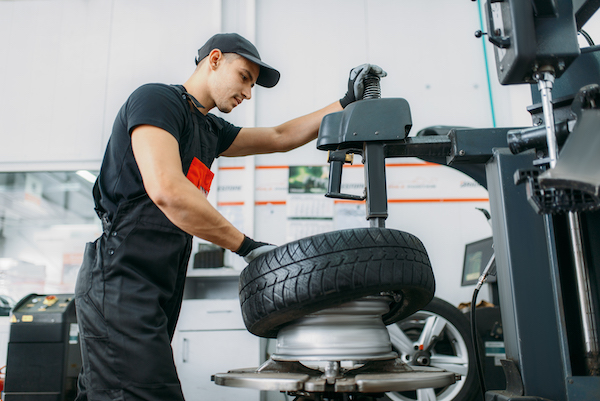Expert Guide to Tire Repair Service: Every Little Thing You Required to Know
In this extensive overview, we will untangle the complexities of tire fixing, losing light on the numerous kinds of repair work sets readily available and offering useful insights into when it may be time to bid farewell to a damaged tire. Stay tuned as we dive deeper into the subtleties of tire upkeep, outfitting you with the necessary expertise to ensure your tires stand the test of time.
Common Causes of Tire Damage
What are the common reasons that cause tire damages, impacting automobile efficiency and security? Tire damages can happen as a result of numerous factors, with among the key factors being improper inflation stress. Under-inflated tires can cause too much warmth accumulation, causing increased wear and possible blowouts. Conversely, over-inflated tires can cause minimized traction, irregular wear, and a harsher trip.

An additional common root cause of tire damages is inadequate step deepness. Damaged treads can endanger grip when traveling, particularly in wet or slippery problems, raising the threat of crashes. In addition, driving over pits, particles, or sharp objects can pierce or trigger cuts in the tire, damaging its structure and potentially creating a flat.
Moreover, inappropriate wheel placement and unbalanced tires can also add to tire damages. Misaligned wheels can result in irregular wear patterns, while out of balance tires can create vibrations, affecting both the automobile's handling and the tire's longevity. Regular upkeep checks and punctual repair services can assist minimize these usual reasons of tire damages, making sure ideal lorry performance and security.
Sorts Of Tire Repair Kits
To address the aftermath of usual sources of tire damage discussed earlier, it is vital to comprehend the different sorts of tire repair work kits available for car proprietors. There are primarily 3 sorts of tire fixing packages generally utilized: plug packages, patch packages, and mix repair work packages.
Plug packages are a quick and easy option for fixing small leaks brought on by nails or screws. They include a T-handle tool and rubber plugs that can be placed into the slit to seal the hole properly. Patch sets, on the various other hand, are better for larger punctures or cuts in the tire. These sets consist of a spot and glue material that is used to the inner lining of the tire to cover the broken area safely.
Combination fixing kits use the advantage of containing both plug and patch components, supplying an extensive remedy for a selection of tire damage circumstances. It is important for car proprietors to acquaint themselves with these different sorts of tire repair sets to be planned for any unforeseen tire concerns when driving.

Steps to Repair a Tire Slit
Fixing a tire slit needs a methodical approach and the right tools to make sure a secure and reliable option. When confronted with a pierced tire, the initial step is to safely pull over to a flat, steady surface far from website traffic. Engage the hand brake and location wheel chocks behind the tires to stop any type of accidental rolling. Next, remove the punctured tire following the automobile manufacturer's standards. Once the tire is eliminated, check the pierced area to locate the international item creating the leakage. Utilize a reaming device to tidy and roughen the puncture hole published here for far better attachment. Apply rubber concrete to the location and put a plug utilizing a plug insertion tool. Trim any type of excess plug product flush with the tire step. Reinflate the tire to the advised pressure and reinstall it onto the car. Conduct a comprehensive leak check using soapy water to guarantee the puncture is efficiently secured before resuming normal driving.
When to Replace a Tire
Figuring out the suitable time for tire replacement requires a complete analysis of different crucial variables related to tire wear and safety. As tires wear down, the deepness of the walk decreases, impacting the tire's grip on the road. Also if the step deepness appears sufficient, tires older than six years should be thoroughly taken a look at, as the rubber can degrade over find here time, making the tire extra vulnerable to failing.

Tire Maintenance Tips for Longevity
After examining key elements related to tire wear and safety and security, applying correct tire maintenance practices is necessary for optimizing the longevity of your tires. Routinely examining tire pressure is important, as underinflated tires can lead to increased wear and lowered fuel performance.
Turning your tires at routine intervals, typically every 5,000 to 7,000 miles, promotes also tread wear across all tires. Inspecting tires for signs of damages, such as cuts, protrudes, or punctures, is also essential for maintaining tire longevity. By adhering to these tire upkeep suggestions, you can optimize the life-span of your tires and ensure a smooth driving experience.
Conclusion
Finally, understanding common reasons for tire damages, making use of the ideal tire repair service kits, following proper actions to repair a tire puncture, recognizing when to replace a tire, and learn the facts here now applying tire maintenance ideas are crucial for making best use of the long life of your tires. By staying educated and positive in resolving tire concerns, you can guarantee safety and security when traveling and prolong the life expectancy of your tires.